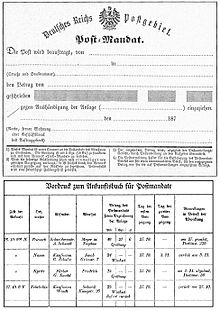Mail order
Germany
Since October 15, 1871, the Reichspost and Wuerttemberg had the postal mandate service, Bavaria followed a month later. The postal orders for collecting money, as they were called since 1875, were required by the trade on the basis of the "German bill of exchange" of 1848. Postal orders were used to collect cash amounts from banks by third parties (the post office) and to present bills of exchange ( checks ) for payment by the recipient of the postal order and the transfer of the collected amount, and, if necessary, to raise a bill protest . Such post-protest orders were possible since 1872.
Post mandates were with the stamp RECOMMANDIERT to provide and were only allowed to the addressee or his authorized representative be handed over, they cost 5 pence (18 Kreuzer ). The mail order letter had to be franked like a registered letter. In addition, there was the postal order fee for transferring the collected amount. As for postal orders, the maximum amount was 50 thalers (87½ guilders ).
With the changeover to the mark currency on January 1, 1875, the maximum amount for postal orders rose to 600 marks and that for postal orders to 300 marks. If necessary, two postal orders had to be filled out. The fee for the mail order was now 30 pfennigs. In 1888 the main amount was increased to 800 marks. In 1923, postage remained the same as for a registered letter , plus a presentation fee of 20 pfennigs and the fee for the postal order or the payment card for transferring the amount collected. The presentation fee was doubled to 40 pfennigs on March 1, 1946 and reduced to 30 pfennigs on September 1, 1948.
On August 1, 1876, the postal order to obtain declarations of acceptance (exchange acceptances ) was introduced, which existed until August 1, 1941. The fee was a) for the postal order letter 30 Pfg., B) a presentation fee of 10 Pfg. (1923 - 20 Pfg.) And c) for the return the fee for a franked registered letter.
The mail order for book shipments was even shorter, which only existed between January 1, 1882 and June 1, 1896. Actually, this was a different form of cash on delivery . The fee was a) the usual printed matter fee , b) a presentation fee of 10 Pfg. And c) the postal order fee .
For postal protest orders , if they were not honored, in 1908 a) a protest fee of up to 500 marks at 1 mark, above 50 Pfg. And b) for the return of the bill of exchange with the protest document 30 Pfg., In the local service 25 Pfg. 1925 the protest fee was 1 Reichsmark as well , for the return, the fee for a prepaid registered letter. Since April 1, 1936, the protest fees have been staggered (for 50 - 1, 100 - 1.50, 200 - 2, 300 - 2.50, 500 - 3 and up to 1,000 marks 4 marks). The certificate of the protest cost 2 marks.
Since March 1, 1963, the fee for testimony and protest has been based on the “Law on Costs in Matters of Voluntary Jurisdiction” (cost regulations) of July 26, 1957 (RGBl. S-874). The cost of formal delivery and the presentation fee increased steadily.
Austria
It is possible to have the amounts due collected by means of a postal order through Österreichische Post AG . Swiss Post charges a fee of € 4.50 (net) for this reminder option. If the debtor pays, the creditor receives the money in his account. In the event of non-redemption (non-payment, refusal of acceptance, debtor moved) or in the event of notification at the nearest post office if the mail order has not been resolved (paid), the creditor will receive the mail order back with appropriate notes. Basically, two attempts are made to recover the property.
This service is also used by the social insurance institute of the commercial economy and the financial administration as well as by municipalities to remind delinquent contributors or tax debtors. In the event of non-payment, a backlog will be issued . The KSV of 1870 also uses the postal order for debt collection cases. In fact, the mail order is a good method to achieve a due date more reliably than with letters.
The general terms and conditions for the mail order service, which replace the provisions of the discontinued postal order, apply to the use of postal orders.
Advance directives
A special feature is the ability to determine advance directives. If the debtor has moved away, "Do not forward" means that the mail order is not forwarded and the creditor receives the mail order back immediately. “Postponement of payment excluded” means that if the debtor is encountered, he must pay immediately. If he refuses, the mail order will be returned immediately with the appropriate note. "Return, if not redeemed by ..." enables the creditor to determine that the mail order will be returned before the expiry of the storage period and that a specific date (e.g. September 12, 2008) must be specified. The end of the "normal" storage period is the third Monday following the notification.
Individual evidence
- ↑ Swiss Post website
- ↑ cf. Section 211 (1) lit e BAO
- ↑ Kommunalnet: The mail order
- ↑ General Terms and Conditions of Mail Order ( Memento of the original from November 17, 2008 in the Internet Archive ) Info: The archive link was automatically inserted and not yet checked. Please check the original and archive link according to the instructions and then remove this notice. (PDF file; 104 kB)
- ↑ Customer specification for online mail

